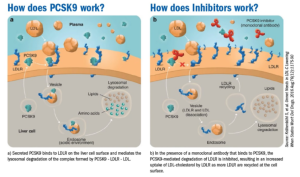2.23 PCSK9 Inhibitors and Small Interfering RNA (siRNA) Drugs
John Smithson
- relate the mechanism of action of PCSK9 inhibitors to their cholesterol lowering effect
- understand the common and catastrophic side effects of the PCSK9 inhibitor class.
Alirocumab (‘ali-roc-u-mab’) and Evolocumab (‘evo-loc-u-mab’)
Proprotein convertase subtilisin/kexin type 9 (PCSK9) inhibitors are a class of drugs that reduce circulating cholesterol levels, particularly low-density lipoprotein cholesterol (LDL-C). PCSK9 is a protein that binds to LDL receptors (LDLR) on the surface of liver cells. Normally, LDL receptors capture LDL-C particles from the bloodstream and internalize them into liver cells, where they are degraded and removed from circulation. However, when PCSK9 binds to LDL receptors, it leads to their degradation, reducing the number of receptors available to clear LDL-C from the blood.
PCSK9 inhibitors, such as monoclonal antibodies, work by binding to PCSK9 and preventing it from attaching to LDL receptors. This inhibition spares the LDL receptors from degradation, allowing them to recycle back to the liver cell surface. With more LDL receptors available, the liver can remove more LDL-C from the bloodstream, thereby significantly lowering the levels of circulating LDL-C. This mechanism is particularly beneficial for patients who have not achieved target LDL-C levels with statins alone or who are intolerant to statins.

- Injection site reactions, rashes, nasopharyngitis, infections (e.g. ‘flu, URTIs, gastroenteritis), hypersensitivity reactions.
Inclisiran (‘in-clis-eran’)
Inclisiran is a small interfering RNA (siRNA) drug designed to reduce the expression of the proprotein convertase subtilisin/kexin type 9 (PCSK9) gene. It targets and binds to the messenger RNA (mRNA) encoding PCSK9, preventing its translation into the PCSK9 protein.
Once inclisiran enters liver cells, it incorporates into the RNA-induced silencing complex (RISC). The RISC-inclisiran complex binds to the PCSK9 mRNA, leading to its cleavage and degradation. This reduces the production of the PCSK9 protein.
With lower PCSK9 levels, the degradation of low-density lipoprotein receptors (LDLRs) on liver cells decreases. Normally, PCSK9 binds to LDL receptors and promotes their degradation, reducing the liver’s ability to remove LDL-C from the blood.
The reduction in PCSK9 levels results in more LDL receptors being available on the surface of liver cells. These receptors bind and remove more LDL-C from the bloodstream, leading to a significant reduction in circulating LDL-C levels.
By this mechanism, inclisiran effectively lowers LDL-C levels, offering a promising therapeutic option for patients with hypercholesterolemia and those at high risk of cardiovascular diseases.
COMMONWEALTH OF AUSTRALIA Copyright Regulations 1969 WARNING
This material has been reproduced and communicated to you by or on behalf of James Cook University in accordance with section 113P of the Copyright Act 1969 (Act).
The material in this communication may be subject to copyright under the Act. Any further reproduction or communication of this material by you may be the subject of copyright protection under the Act. Do not remove this notice.
